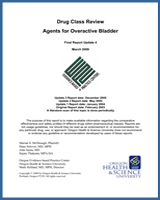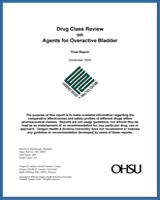Overactive bladder syndrome (OAB) is defined by the International Continence Society (ICS) as a medical condition referring to the urinary symptoms of frequency and urgency, with or without urge incontinence, when appearing in the absence of local pathological factors. Nocturia is also commonly present. The purpose of this review is to compare the efficacy, effectiveness, and adverse effects of the pharmacological treatments for OAB. Pharmacological treatment includes darifenacin, flavoxate hydrochloride, hyoscyamine, oxybutynin chloride, tolterodine tartrate, trospium chloride, scopolamine transdermal, and solifenacin succinate.
Contents
- Introduction
- Methods
- Results
- Overview
- Systematic Reviews
- Key Question 1. For adult patients with urinary urge incontinence/overactive bladder, do anticholinergic OAB drugs differ in effectiveness?
- Quality of life
- Abstracts: Assessment of Publication Bias
- Key Question 2. For adult patients with urinary urge incontinence/overactive bladder, do anticholinergic OAB drugs differ in safety or adverse effects?
- CNS Adverse Events
- Withdrawal Due to Adverse Events
- Drug Interactions
- Abstracts: Assessment of Publication Bias
- Key Question 3. Are there subgroups of patients based on demographics (age, racial groups, gender), other medications, or co-morbidities for which one anticholinergic incontinence drug is more effective or associated with fewer adverse effects?
- Summary and Discussion
- Flavoxate
- Scopolamine
- Hyoscyamine
- Evidence of Comparative Efficacy: Oxybutynin versus Tolterodine
- Evidence of Comparative Efficacy: Oxybutynin versus Trospium
- Evidence of Comparative Efficacy: Tolterodine versus Solifenacin
- Evidence of Comparative Adverse Events: Oxybutynin versus Tolterodine
- Evidence of Comparative Adverse Events: Oxybutynin versus Trospium
- Evidence of Comparative Adverse Events: Darifenacin versus Oxybutynin
- Evidence of Comparative Adverse Events: Solifenacin versus Tolterodine
- Evidence of Comparative Efficacy or Adverse Events in Subgroup: Oxybutynin versus Tolterodine or Trospium
- References
- Appendixes
- Evidence Tables
The purpose of this report is to make available information regarding the comparative effectiveness and safety profiles of different drugs within pharmaceutical classes. Reports are not usage guidelines, nor should they be read as an endorsement of, or recommendation for, any particular drug, use or approach. Oregon Health & Science University does not recommend or endorse any guideline or recommendation developed by users of these reports.

